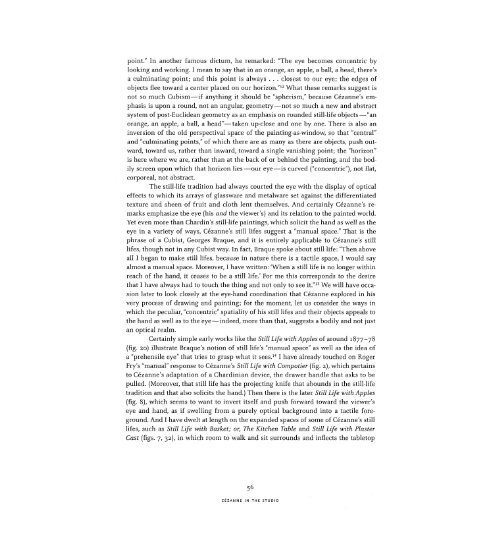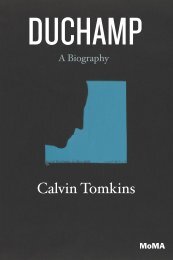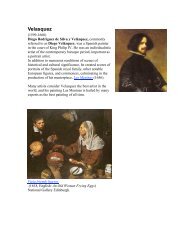Still Life in Watercolors
qbj8dgc
qbj8dgc
- No tags were found...
Create successful ePaper yourself
Turn your PDF publications into a flip-book with our unique Google optimized e-Paper software.
po<strong>in</strong>t." In another famous dictum, he remarked: "The eye becomes concentric by<br />
look<strong>in</strong>g and work<strong>in</strong>g. I mean to say that <strong>in</strong> an orange, an apple, a ball, a head, there's<br />
a culm<strong>in</strong>at<strong>in</strong>g po<strong>in</strong>t; and this po<strong>in</strong>t is always . . . closest to our eye; the edges of<br />
objects flee toward a center placed on our horizon." 12 What these remarks suggest is<br />
not so much Cubism—if anyth<strong>in</strong>g it should be "spherism," because Cezanne's emphasis<br />
is upon a round/not an angular, geometry—not so much a new and abstract<br />
system of post-Euclidean geometry as an emphasis on rounded still-life objects—"an<br />
orange, an apple, a ball, a head"—taken up-close and one by one. There is also an<br />
<strong>in</strong>version of the old perspectival space of the pa<strong>in</strong>t<strong>in</strong>g-as-w<strong>in</strong>dow, so that "central"<br />
and "culm<strong>in</strong>at<strong>in</strong>g po<strong>in</strong>ts," of which there are as many as there are objects, push outward,<br />
toward us, rather than <strong>in</strong>ward, toward a s<strong>in</strong>gle vanish<strong>in</strong>g po<strong>in</strong>t; the "horizon"<br />
is here where we are, rather than at the back of or beh<strong>in</strong>d the pa<strong>in</strong>t<strong>in</strong>g, and the bodily<br />
screen upon which that horizon lies—our eye—is curved ("concentric"), not flat,<br />
corporeal, not abstract.<br />
The still-life tradition had always courted the eye with the display of optical<br />
effects to which its arrays of glassware and metalware set aga<strong>in</strong>st the differentiated<br />
texture and sheen of fruit and cloth lent themselves. And certa<strong>in</strong>ly Cezanne's remarks<br />
emphasize the eye (his and the viewer's) and its relation to the pa<strong>in</strong>ted world.<br />
Yet even more than Chard<strong>in</strong>'s still-life pa<strong>in</strong>t<strong>in</strong>gs, which solicit the hand as well as the<br />
eye <strong>in</strong> a variety of ways, Cezanne's still lifes suggest a "manual space." That is the<br />
phrase of a Cubist, Georges Braque, and it is entirely applicable to Cezanne's still<br />
lifes, though not <strong>in</strong> any Cubist way. In fact, Braque spoke about still life: "Then above<br />
all I began to make still lifes, because <strong>in</strong> nature there is a tactile space, I would say<br />
almost a manual space. Moreover, I have written: 'When a still life is no longer with<strong>in</strong><br />
reach of the hand, it ceases to be a still life.' For me this corresponds to the desire<br />
that I have always had to touch the th<strong>in</strong>g and not only to see it." 13 We will have occasion<br />
later to look closely at the eye-hand coord<strong>in</strong>ation that Cézanne explored <strong>in</strong> his<br />
very process of draw<strong>in</strong>g and pa<strong>in</strong>t<strong>in</strong>g; for the moment, let us consider the ways <strong>in</strong><br />
which the peculiar, "concentric" spatiality of his still lifes and their objects appeals to<br />
the hand as well as to the eye—<strong>in</strong>deed, more than that, suggests a bodily and not just<br />
an optical realm.<br />
Certa<strong>in</strong>ly simple early works like the <strong>Still</strong> <strong>Life</strong> with Apples of around 1877-78<br />
(fig. 20) illustrate Braque's notion of still life's "manual space" as well as the idea of<br />
a "prehensile eye" that tries to grasp what it sees. 14 I have already touched on Roger<br />
Fry's "manual" response to Cezanne's <strong>Still</strong> <strong>Life</strong> with Compotier (fig. 2), which perta<strong>in</strong>s<br />
to Cezanne's adaptation of a Chard<strong>in</strong>ian device, the drawer handle that asks to be<br />
pulled. (Moreover, that still life has the project<strong>in</strong>g knife that abounds <strong>in</strong> the still-life<br />
tradition and that also solicits the hand.) Then there is the later <strong>Still</strong> <strong>Life</strong> with Apples<br />
(fig. 8), which seems to want to <strong>in</strong>vert itself and push forward toward the viewer's<br />
eye and hand, as if swell<strong>in</strong>g from a purely optical background <strong>in</strong>to a tactile foreground.<br />
And I have dwelt at length on the expanded spaces of some of Cezanne's still<br />
lifes, such as <strong>Still</strong> <strong>Life</strong> with Basket; or, The Kitchen Table and <strong>Still</strong> <strong>Life</strong> with Plaster<br />
Cast (figs. 7, 32), <strong>in</strong> which room to walk and sit surrounds and <strong>in</strong>flects the tabletop<br />
56<br />
CÉZANNE IN THE STUDIO




